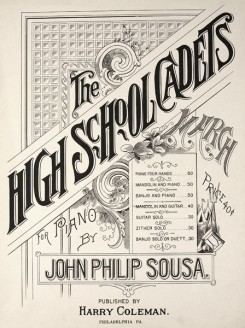Form IAABBCCDD | Composed 1890 | |
 | ||
"High School Cadets" is a march written in 1890 by John Philip Sousa in honor of the cadet drill team of Washington High School in the District of Columbia. It is in regimental march form (I-AA-BB-CC-DD) and is a popular selection for school concert and marching bands, as well as for professional orchestras and bands. The march has been arranged for a wide variety of instruments and ensembles, and has been frequently recorded, including at least two recorded performances by Sousa's own band. The march's final strains were featured in the 1939 film The Under-Pup.
Contents
History
In 1888, John Philip Sousa composed The March Past of the National Fencibles, in honor of a renowned militia drill team affiliated with the National Guard of the District of Columbia. In 1890, the rival drill team of the Washington High School (subsequently Washington Central) asked Sousa, a native of the District, to compose a march for them, and he obliged with The High School Cadets March, now generally known simply as High School Cadets. High School Cadets quickly became one of Sousa's most popular marches. Just four years after its composition, the Nebraska State Journal listed it as one of the composer's "most notable" marches, along with Washington Post March, Liberty Bell March, and several others. It was recorded by Sousa's Grand Concert Band around 1899 and has been frequently recorded ever since (see Recordings).
The march was published in 1890 by Philadelphia music publisher Harry Coleman in arrangements for band, for piano solo and for several other small instrumental ensembles.(see Arrangements.) Subsequently the copyright was picked up by Carl Fischer Music of New York, which continues to list the march in its catalog, both in the original form and in a modern arrangement. The copyright on the original score was renewed by Sousa in 1918; it has now expired and the work is in the public domain in the United States.
High School Cadets continues to be frequently performed, both by professional ensembles and by amateur and school bands. (See External links.)
Musical structure & instrumentation
High School Cadets is in the form of a regimental march, consisting of four repeated musical strains with a short introduction: I-AA-BB-CC-DD. An alternate form plays all four strains without repeats, and then recapitulates the whole march (minus the introduction): I-ABCD-ABCD. This variant is popular with marching bands and was also used by the Edison Military Band in their 1907 recording. (see Recordings)
Each strain is 16 bars in length except the A strain, which is 24 bars long. The A theme, in D-flat major, is "an energetic, somewhat jaunty creation, punctuated by crescendos and exuding a sense of tension... more from happy excitement than from stress or agitation." The second strain derives uplift from the repeated motif of a three-note rising scale, and it ends with a complete ascending chromatic scale (see illustration). The C strain is "a quiet and sonorous trio in G-flat," while the D strain returns to the three-note rising scale motif, with almost every note in the whole strain accented. Conductor Frederick Fennell describes the D theme as:
some of the most wide-open, free-swinging band music I know. Sousa's use of the trombones to intone the first three notes only and then other fragments of the melody while the rest of the tune keepers carry on with the melody makes all the difference.
The use of trombones to emphasize selected elements of melody, as mentioned by Fennell, is characteristic of Sousa's scoring throughout his career. But in certain other respects, the instrumentation of High School Cadets displays its place in the evolution of the composer's ideas about scoring. This march makes use of alto and bass clarinets, and also of alto, tenor and baritone saxophones – all instruments seldom used in Sousa's early works but common in his post-1890 compositions. But the upper brass section consists only of B♭ cornets; the score does not call for either E♭ cornets (used in Sousa's early marches) nor for trumpets (which Sousa began to use after about 1895). High School Cadets is also unusual in having parts for both euphonium and baritone horn; most Sousa compositions include a single part that can be played by either instrument. The fact that the score includes parts for tympani and orchestral bells suggests that Sousa conceived High School Cadets not simply as a piece for marching band, but for concert band as well.
Arrangements
The original edition of High School Cadets, as published in 1890 by Harry Coleman, included arrangements for band and also for:
It has also been arranged for:
Modern band arrangements include:
Recordings
Sousa had a poor opinion of recorded music, considering that it would reduce the incentive to play live music and fearing its implications for the intellectual property rights of composers and musicians. However, he recognized the growing public interest in recordings, and despite his personal reservations he allowed his works to be recorded by numerous ensembles including his own band, although he generally declined to attend the recording sessions and designated others to serve as bandleaders for these occasions. High School Cadets proved popular with recording orchestras and bands, both in Sousa's era and in modern times.
